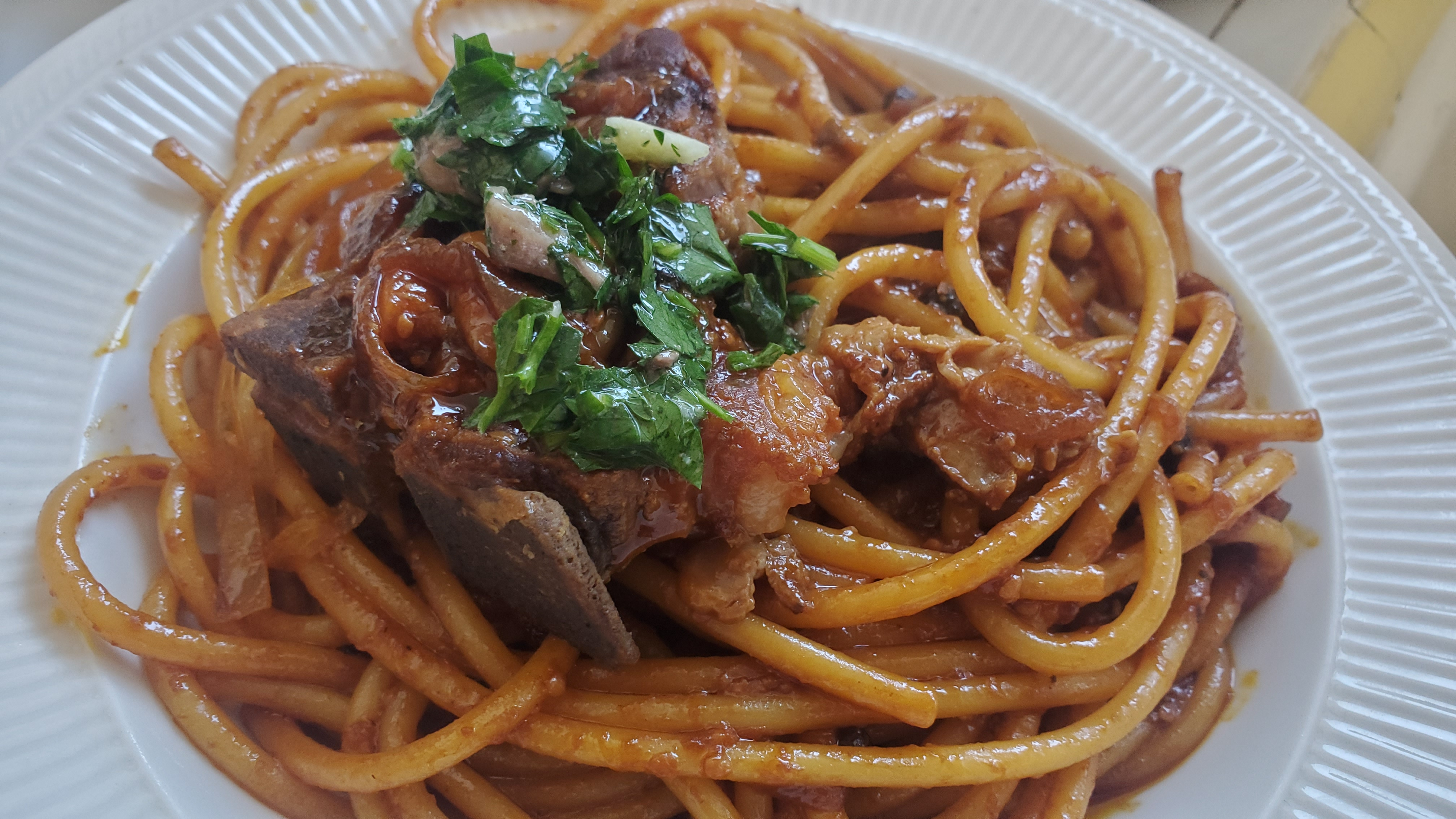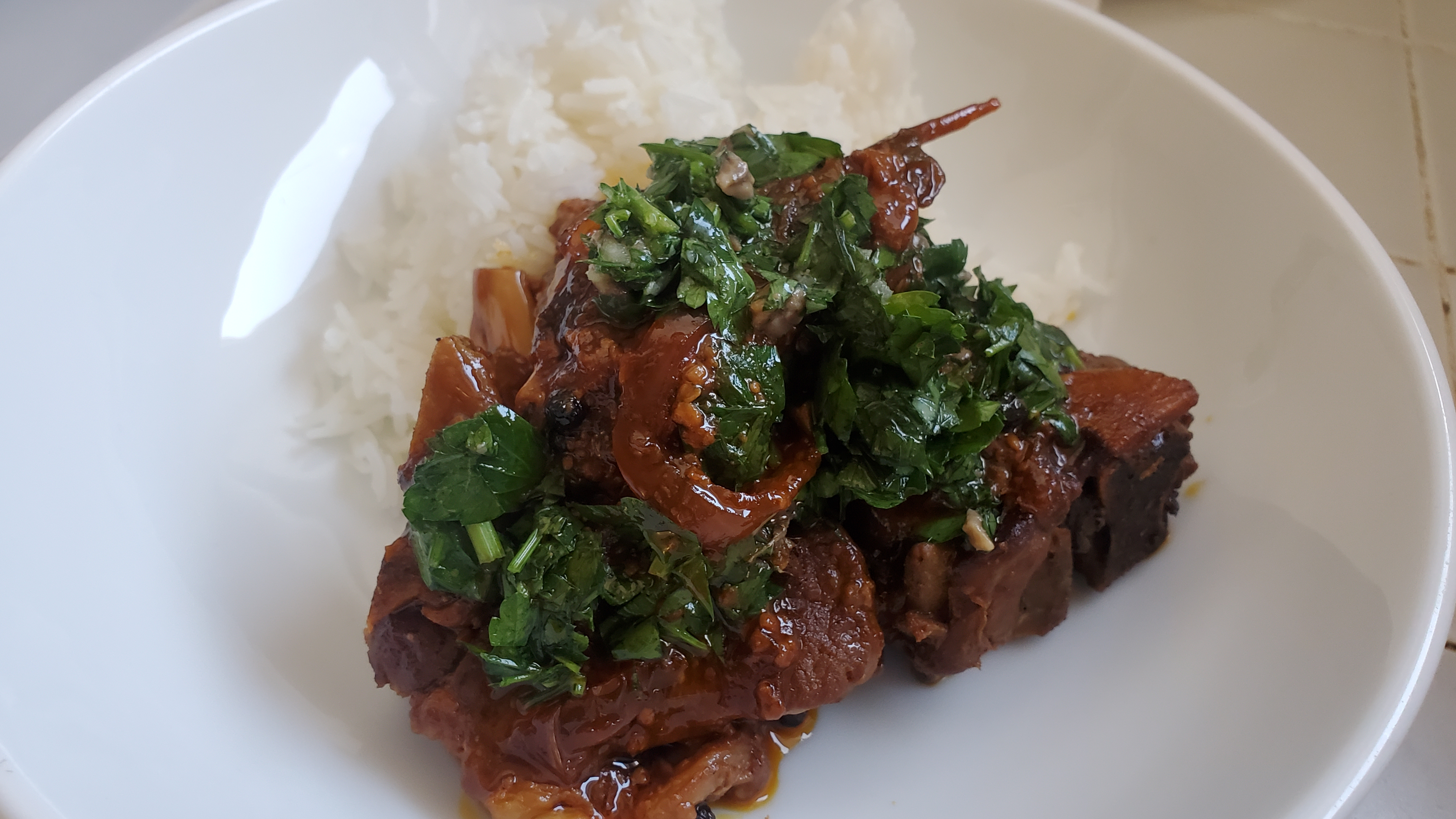Make Bright, Tangy Adobo If You Want Your House To Smell Immaculate
Filipino food is all about vinegar, so let's get it swirling in in the air.
There is no greater food smell than adobo. The slow roasting of meat, aromatics, and herbs. The piercing aroma of simmering coconut vinegar. A good adobo jolts you alive. It's a dart; a restorative, hearty dish that shakes you awake with its piquancy. And it's all thanks to vinegar.
Vinegar is what a lot of food tends to be missing. Since I became familiar with Filipino food, I began to crave more vinegar. I want it in my pasta sauce, near my fried rice, and on top of my pierogi. I want a little bottle of it stationed on the table at all times, ready for action. I'm a vinegar fiend these days, and I have Filipino food to thank for my new tasty addiction. It's everywhere in their cuisine.
Filipino food and adobo
All the various Filipino ceviche like sinuglaw (pork belly and fish) and kinilaw (just fish) feature white sugarcane vinegar and coconut vinegar. Sinigang is a sour soup made with tart fruits, citrus, and vinegar. Sawsawan is a table-side vinegar condiment that takes on many different iterations, often infused with different herbs, spices, fruits, and vegetables. And then, of course, the aforementioned adobo, which can be loosely defined as anything cooked in vinegar.
The vast, rich cuisine moved me so much that eventually I picked up Nicole Ponseca's I Am A Filipino: And This is How We Cook. It's a lovely tutorial that breaks down Filipino food into four distinct flavors, or mother sauces: sour, coconut, funk, and tomato. Me? I like a lot of funk and sour.
That's why I keep coming back to adobo, which is full of those enticing flavors but simple to prepare. It's the one-pot, freestyle, dutch oven cooking that I find to be the least pretentious, and thus, the most gratifying. Adobo is not only part of my regular dinner routine, it has also become a way for me to reconnect with soulful, joyous cooking. And for that, I am eternally grateful for Ponseca's book.
Lamb works great for adobo, because bone-in lamb has a ton of flavor—there's no need to add any kind of stock to the pot. In her book, Ponseca uses lamb shanks; here, I use lamb chops. Anything with a bone in it will do, although admittedly the shanks are best.
Substitutions can be made for most of the ingredients below, but spring for things like coconut vinegar (you can buy it online) and annatto seeds. I like to make a fresh gremolata with which to top the lamb before serving. It's another layer of funky acidity, something that I like to double down on.
The adobo sauce is so good that it works great with rice or pasta. Feel free to ignore the pasta if you prefer rice. It's your world, baby. But this recipe got me thinking I might be throwing a lot more vinegar into my pasta sauces moving forward—and when I do, I'll be sure to share the recipes.
For the Achiote Oil:
- 1/4 cup annatto seeds
- 1 cup grapeseed oil
Put the oil and annatto seeds into a small saucepan or pot. Turn the heat to medium. Warm, while stirring, for 3-4 minutes or until the oil has turned deep orange and red. Let cool for 5 minutes, then strain through a fine mesh sieve. Discard the seeds.
For the Gremolata:
- 2 bunches parsley
- 2 cloves garlic, finely minced
- 1 lemon
- 1 can (2 ounces) anchovies, diced; use half if you're reluctant
- 1 Tbsp. extra-virgin olive oil
- Ground pepper to taste
Chop the stems from the bunch of parsley in one fell swoop, and don't worry about completely dissecting each one. Parsley stems carry a lot of flavor in their own right, so it's fine to leave a few in there.
Add the garlic and anchovies. Make sure to add the oil from the can as well. Squeeze and zest in a whole lemon. Now add a tablespoon of olive oil, stirring together while adding ground pepper. (The anchovies are salty enough that you don't need to add any salt to this recipe.)
For the Lamb Adobo:
- 1½ lbs. bone-in lamb chops or lamb shanks
- 3 Tbsp. grapeseed oil
- 7 cloves garlic
- 1/2 large onion
- 4 serrano peppers
- 1 cup achiote oil
- 1 cup coconut vinegar
- 1/2 cup white vinegar
- 1/4 cup fish sauce
- 3 Tbsp. red miso paste
- 2 tsp. black peppercorns
- 3 bay leaves
- 2½ cups water
- 8 oz. bucatini or spaghetti
Instructions:
Preheat the oven to 350 degrees.
In a small dutch oven, add the 3 tablespoons of grapeseed oil and turn the heat to medium. Season both sides of your lamb well with salt and pepper. Once the bottom of the dutch oven is hot, place your lamb in so that it sizzles gently. Sear both sides, achieving a nice browning. If you're going with lamb chops, it should only take 2-3 minutes on each side. Shanks are thicker, so probably about 5 minutes per side. Once they're nice and browned, remove them from the pan into a side dish. Empty out most of the fat/oil, aside from a few tablespoons.
Next, crush the cloves of garlic, slice the onion thinly, and split the serrano peppers in half. Discard the serrano pepper seeds if you wish, but I add them in. In the dutch oven again over medium heat, add the garlic, onion, and serranos with a generous pinch of salt. Stir and cook, not long, for about 2 minutes.
Next, add the rest of the ingredients to the dutch oven: the achiote oil, both vinegars, the fish sauce, the miso, the bay leaves, and the peppercorns. Whisk together, stirring to incorporate everything into the mixture. Place the lamb into the dutch oven. Now, add enough water to submerge the lamb completely. This should be about 2½ cups, but adjust accordingly. Bring to a light simmer, then place a lid on top and put the whole thing directly into the oven. Cook for 2 hours, being sure to take it out of the oven and stir once halfway through. Also, take a second to appreciate all the smells you've just created.
After 2 hours, take the whole thing out of the oven. Remove the lamb and place into a side dish. On medium heat, start to reduce the adobo mixture. This is a great time to take a spatula or wooden spoon and scrape off all that delicious fond, aka the stuff that has accumulated on the sides of the dutch oven. (This will also help thicken the adobo sauce.) After about 10-15 minutes on medium heat, the sauce should be good and thickened.
Meanwhile, cook the bucatini to desired doneness. If you undercook it and finish it in a pan with a little pasta water and a ladle of the adobo sauce, that last little bit of cooking will infuse the pasta with an bonus amounts of flavor. Pick out the bay leaves, but consider leaving in the peppercorns; I think that a nice peppery bomb of peppercorn every so often is lovely.
Top with gremolata for that extra funky, acidic kick.

